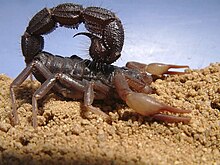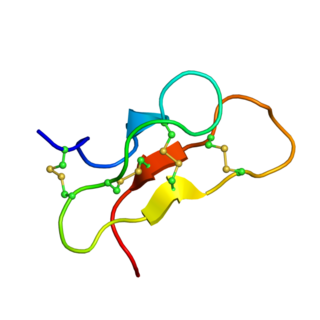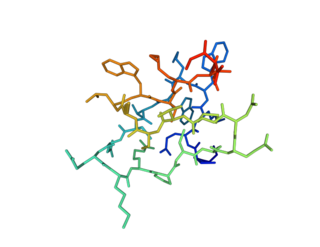This article relies largely or entirely on a single source .(March 2018) |
Altitoxin is a neurotoxin found in the South African scorpion Parabuthus transvaalicus . Injection of altitoxin in mice leads to akinesia, depression and death. [1]
This article relies largely or entirely on a single source .(March 2018) |
Altitoxin is a neurotoxin found in the South African scorpion Parabuthus transvaalicus . Injection of altitoxin in mice leads to akinesia, depression and death. [1]

Altitoxin is secreted by the venom gland of the South African spitting (or fattail) scorpion Parabuthus transvaalicus. [1]
Altitoxin, with the amino acid sequence ADVPGNYPLDKDGNTYTCLELGENKDCQKVCKLHGVQYGYCYAFFCWCKELDDKDVSV, is 58 amino acid residues long and has a molecular mass of 6598 Da; it has 3 disulfide bridges (Cys18-Cys41, Cys27-Cys46, and Cys31-Cys48). [1] It has large homology to other toxins from the venom of Parabuthus transvaalicus, including bestoxin, birtoxin, ikitoxin and dortoxin.
Altitoxin has sequence homology to scorpion β-toxins, suggesting it might target sodium channels. However, its depressing action following injection into mice [1] is not in agreement with the effect of β-toxins on sodium channels. Related scorpion toxins, which include birtoxin and bestoxin, exhibit highly divergent biological activity, [1] indicating that the mode of action of these toxins is highly diverse.
An injection of 100 ng altitoxin in 20 g mouse (ED99) causes a state of akinesia and depression. Lethality is reached at injecting 200 ng. [1]
Kurtoxin is a toxin found in the venom of the South African scorpion Parabuthus transvaalicus. It affects the gating of voltage-gated sodium channels and calcium channels.
Birtoxin is a neurotoxin from the venom of the South African Spitting scorpion. By changing sodium channel activation, the toxin promotes spontaneous and repetitive firing much like pyrethroid insecticides do
Bestoxin is a neurotoxin from the venom of the South African spitting scorpion Parabuthus transvaalicus. Most likely, it targets sodium channel function, thus promoting spontaneous and repetitive neuronal firing. Following injection into mice, it causes non-lethal writhing behaviour.
BmKAEP is a neurotoxin from the venom of the Manchurian scorpion (Mesobuthus martensii). It is a β-toxin, which shift the activation voltage of sodium channels towards more negative potentials.
Dortoxin is a lethal peptide toxin which is secreted by the South African spitting scorpion Parabuthus transvaalicus. Injection of pure dortoxin in mice leads to hyperactivity that lasts until death.
Bukatoxin is an α-scorpion toxin found in the venom of the Chinese scorpion Buthus martensi Karsch. By blocking the inactivation of sodium ion channels, α-scorpion toxins prolong action potentials.
Ikitoxin is a neurotoxin from the venom of the South African Spitting scorpion that targets voltage-sensitive sodium channels. It causes unprovoked jumps in mice following intracerebroventricular injections.

delta-Palutoxins (δ-palutoxins) consist of a homologous group of four insect-specific toxins from the venom of the spider Pireneitega luctuosa. They show a high toxicity against Spodoptera litura larvae by inhibiting sodium channels, leading to strong paralytic activity and eventually to the death of the insect.
Hainantoxins (HNTX) are neurotoxins from the venom of the Chinese bird spider Haplopelma hainanum. Hainantoxins specifically inhibit tetrodotoxin-sensitive Voltage-gated sodium channels, thereby causing blockage of neuromuscular transmission and paralysis. Currently, 13 different hainantoxins are known, but only HNTX-I, -II, -III, -IV and -V have been investigated in detail.
Heteroscopine (HS-1) is the main component of the venom of Heterometrus laoticus. It belongs to the Scorpine toxin family. It is a polypeptide consisting of a defensin-like component on its N-terminal end and a putative potassium channel blocking component on its C-terminal end. It has antimicrobial effect on some bacteria, but not on fungi.
BotIT2 is a neurotoxin from the scorpion Buthus occitanus tunetanus, which modifies activation and slows down the deactivation of voltage gated sodium channels.
Cangitoxin, also known as CGTX or CGX, is a toxin purified from the venom of the sea anemone Bunodosoma cangicum, which most likely acts by prolonging the inactivation of voltage-gated sodium channels.
Tamulotoxin is a venomous neurotoxin from the Indian Red Scorpion.
LmαTX3 is an α-scorpion toxin from Lychas mucronatus. that inhibits fast inactivation of voltage gated sodium-channels (VGSCs).
Beta-mammal toxin Cn2, also known as Cn2 toxin, is a single chain β-scorpion neurotoxic peptide and the primary toxin in the venom of the Centruroides noxius Hoffmann scorpion. The toxin specifically targets mammalian Nav1.6 voltage-gated sodium channels (VGSC).
Neurotoxin B-IV is a venom peptide secreted by a large marine worm called Cerebratulus lacteus that inhabits the northeastern coast of North America. This neurotoxin belongs to a major type of B polypeptide neurotoxins, which appear to be selectively toxic for crustaceans. The mode of action for neurotoxin B-IV has not been clearly established. However, it is likely that B neurotoxins prolong the repolarization phase of action potentials by interacting with voltage-gated sodium channels.
LmαTX5 is an α-scorpion toxin which inhibits the fast inactivation of voltage-gated sodium channels. It has been identified through transcriptome analysis of the venom gland of Lychas mucronatus, also known as the Chinese swimming scorpion – a scorpion species which is widely distributed in Southeast Asia.

GiTx1 (β/κ-theraphotoxin-Gi1a) is a peptide toxin present in the venom of Grammostola iheringi. It reduces both inward and outward currents by blocking voltage-gated sodium and potassium channels, respectively.

Delta hexatoxin Hv1 is a neurotoxic component found in the venom of the Australian funnel web spider.
Tb1 is a neurotoxin that is naturally found in the venom of the Brazilian scorpion Tityus bahiensis. Presumably by acting on voltage-gated sodium channels, it triggers excessive glutamate release, which can lead to both behavioral and electrographic epileptiform alterations, as well as neuronal injury.